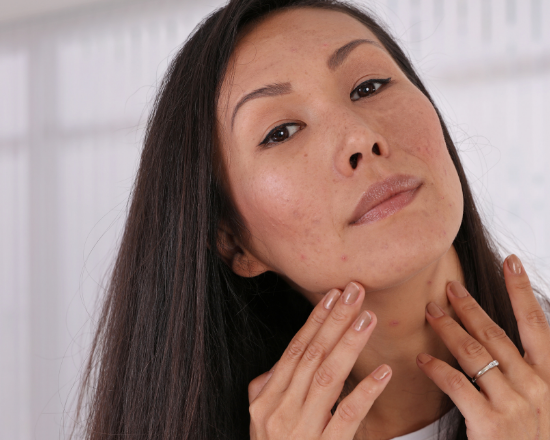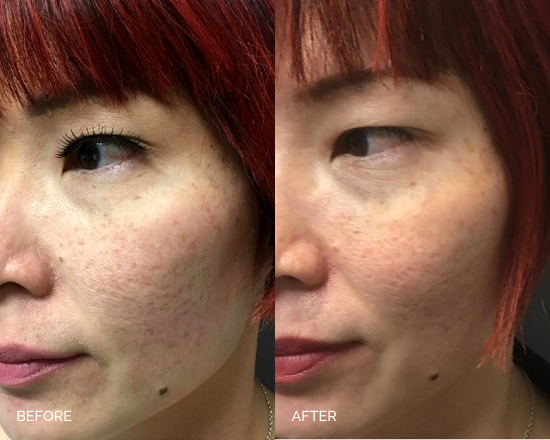
At Ultimate Aesthetics we have experienced doctors can safely and effectively treat moderate to deep acne scars.
Advanced subcision technique is used to release tethered scars that are bound down and depressed due to an underlying scar tissue.

What is Subcision for Acne Scars?
Subcision is an acne scar treatment that works on only scars that are depressed; it addresses the cause of the skin depression and corrects it in order to reduce the appearance of the scarring.
The procedure is relatively simple. Individual scars are treated with a tiny hypodermic needle that is inserted into the skin and moved around in a fanning pattern. This effectively cuts the fibrotic scar tissue that tethers the scar to the underlying tissue. Once the tissue is cut, that layer of your skin will no longer be pulled downward, thereby treating the depressed shape of the scar.
After the procedure is completed, your skin will continue to heal as more collagen is produced in response to the procedure.
After the treatment, the area may appear swollen or bruised. Swelling normally subsides after 2-3 days and bruising takes between 7 and 10 days to fade completely. Because the treatment is so non-invasive, you will be able to return to work or school immediately after and you are safe to drive yourself.


What are the indications for subcision?
The decision to perform subcision will depend on the type, location, and severity of scarring; patient preference and expectations; and clinician experience and expectations.
Subcision may be used for the treatment of:
• Depressed distensile scars (due to acne, trauma, surgery )
• Depressed bound down scars (due to acne*, varicella (chickenpox), trauma, surgery )
• Depressed skin grafts
• Wrinkles
• Cellulite dimples
*excluding deep ice-pick scars

Is Subcision for Acne Scars Right for Me?
A free, no-obligation consultation with Dr. Carolyn Choy can help you determine which procedure is right for you. There are many factors to consider with any cosmetic treatment.
Your treatment plan is formulated after a thorough clinical assessment and is based upon the following factors:
• Type and severity of scarring
• Patient’s medical history
• History of any previous treatments for scarring
• Patient’s skin type
• Patient’s budget and result expectations
• Social downtime concern
To book a complimentary consultation today, click below.

Frequently Asked Questions
- +How many treatments are required?
Individuals vary in their ability to form collagen (scar tissue). The number of subcisions required to correct a depression will depend on the type, location, severity of depression, and intensity of treatment.
Three to six visits suffice for the majority of cases of moderate scarring. Intervals of at least one month in-between treatments are generally recommended.- +What is subcision and how does it work?
Subcision is a minor surgical procedure used for treating depressed cutaneous scars and wrinkles. It is also called subcutaneous incisional surgery.
Subcision is performed using a special hypodermic needle inserted through a puncture in the skin surface. The sharp edge of the needle is used to break fibrotic strands that are tethering the scar to the underlying tissue.
The release of the fibrotic strands and new collagen deposition caused by wound healing leads to cosmetic improvement of the scar. Subcision can be safely performed in the outpatient setting and is usually well tolerated.
- +What is the outcome after subcision?
In appropriate cases, the results can be excellent. Treatment may need to be repeated.
- +What happens after the procedure?
Immediately after subcision:
• Pressure and ice are applied to the operated site to maintain haemostasis and reduce the risk of bleeding.
• Make-up may be applied to camouflage bruised areas.
• Some authors recommend antibiotics and anti-inflammatory medication.The number and intensity of subcisions should be limited on the first treatment to review the patient’s response, particularly when treating areas with a predilection for a hypertrophic reaction after subcision.
- +How is subcision performed?
The procedure of subcision is described below.
1. The area to be treated is cleansed to remove dirt and make-up
2. The scar margins may be defined with a surgical marker, adjusting overhead lighting to delineate depressions.
3. Local anesthetic is infiltrated.
4. A tri-bevelled needle (number 18 or 20 gauge) or a Nokor needle (fig.3) is inserted at an acute angle adjacent to the scar with the bevel upwards and parallel to the skin surface. Smaller gauge needles (25–27) may be used for small superficial scars and wrinkles.
5. The needle is advanced through the dermis and moved back and forth in a fan-like motion. A snapping sound is heard as fibrous bands are transected in the deep dermis and deep dermal subcutaneous plane.*
6. The needle is rotated 90 degrees and moved again in a fan-like motion through the dermal scar (fanning subcision).
7. The needle is removed and squeezed circumferentially around the exit point to prevent large haematoma formation due to bleeding.
8. Manual pressure is applied to the wound for several minutes.*A common pitfall is to fan too deeply in a plane below the dermis

